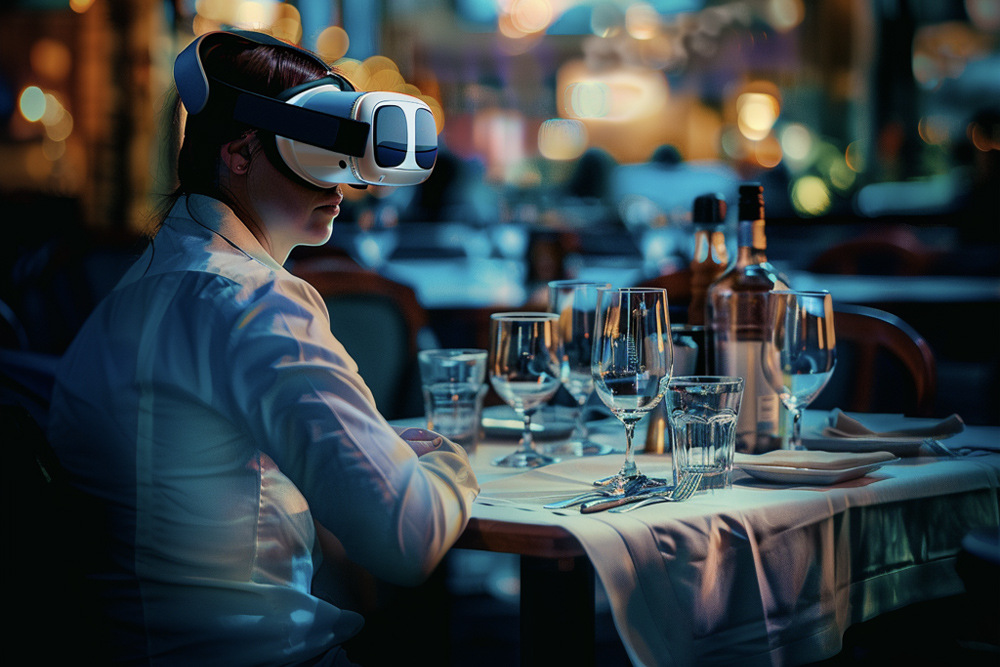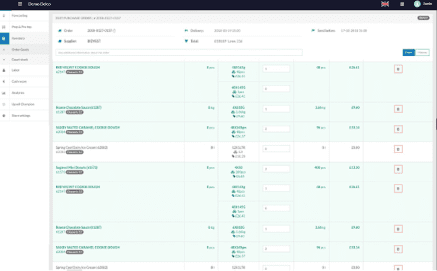The rise of artificial intelligence in the restaurant industry has been a hot topic for some time now, generating excitement and concern in equal measure. In some quarters, AI is seen as a direct threat to job security, while in others AI is viewed as a powerful, transformative tool.
Whether you think artificial intelligence is invasive or irreplaceable, there’s simply no denying that this disruptive technology is opening up significant growth opportunities for business owners, none more so than in the F&B sector.
Previously, a lot of the chatter around AI was dominated by abstract ideas about its future impact, especially in food tech circles. The talk always seemed to be about what it was going to do instead of what it could do.
But the conversation has starting to shift from hypothetical propositions to present-day realities. AI is happening now.
By way of example, we’ll be showcasing 10 areas in which AI is drastically changing how F&B operators are doing business. There’s quite a lot to get through, so we’ve split our guide into two parts. For part one, our focus is on 1- 5.
1. Forecasting
When it comes to AI in restaurants, this is the silver bullet. Demand forecasting is of course essential for any business operating in the F&B sector, be it a fast-food outlet or full-service restaurant. When conducted properly, forecasting can take the guesswork out of procurement purchases, ensuring you've got enough stock in at the right time. It's also easier create accurate employee schedules so that your staff levels are balanced with customer demand.
And it’s in this area that artificial intelligence excels. The latest next-gen tools can process vast amounts of data faster and more accurately than humans. In turn, the AI algorithms are better able to recognise complicated patterns in historical sales data that may otherwise be missed. External variables can also be taken into account such as seasonality, the weather, peak hours/days, holidays and local events.

This is especially useful for producing accurate ingredient-based forecasts. Say for instance, you run a pizza restaurant that sells an average of 15 margarita pizzas between the hours of 1pm to 2pm. A fully-integrated AI-platform can identify all of the ingredients you'll need to fulfil this demand, ensuring that your inventory is sufficiently stocked.
The latest AI-tools can also understand delivery cycles. So if you receive your root vegetables on a Monday, Wednesday and Friday, this is factored in when calculating stock levels. This means that AI can build precise purchase orders for suppliers that are based on accurate data as opposed to gut-feeling.
For restaurants, the results are often transformative, leading to significant reductions in waste and supplier costs. The impact can be felt front-of-house too. With a well-balanced inventory, there’s less chance of dishes becoming unavailable which has a knock-on effect with customer satisfaction.
These benefits are now widely recognised in the F&B sector. In a recent industry survey, 41% of restaurant owners said they planned to invest in AI forecasting tools in 2024.
2. Employee Scheduling
Ensuring you’ve got enough staff to handle customer volume, especially during peak times, is critical for ensuring operational efficiency.
On the other hand, having more staff than is necessary means paying employees for unneeded hours. This is perhaps why labour costs are one of the largest expenses in the F&B industry – many restaurants simply fail to balance customer demand with staffing levels.
But thanks to the latest AI hospitality solutions, it becomes much easier for business owners to strike a balance. As with forecasting, advanced AI tools analyse historical sales data, again factoring in demand variables such as seasonality, the weather, peak hours/days, holidays and local events.

With this data, an advanced restaurant management platform that uses AI will be able to optimise employee schedules, ensuring that the right mix of staff are available for any given period. If we use a pizza outlet as an example, the AI can calculate the number of employees required to fulfil an order. Typically this will comprise an order-taker, a chef to prepare and cook the pizza and a server/delivery driver.
In other words, AI can build a staff schedule that perfectly balances demand with staffing levels. This has the potential to dramatically reduce labour costs and protect those margins.
4. Cooking and Assembly
Cooking and assembly are on the cusp of major upheaval as robotic automation is gradually being introduced to commercial kitchens. Until fairly recently, robotics in the food and beverage industry didn’t look to be much of growth area. In fact a lot of robotics start-ups, such as pizza-maker Zume, have closed down over the past few years.
But many of these companies have focused on front-of-house gimmickry, attempting to keep customers amused with their WOW factor robot servers. Some still operate successfully though, including Barista’s coffee-making robot, Adam and robot food runner, Servi.
Yet, US companies like Chef Robotics are finding more success by focusing on back-of-house practicalities, specifically the automation of production processes with AI-enabled robots. Flippy the Kitchen Robot provides a similar, albeit limited solution for fast-food outlets, working alongside humans to prepare side orders.
There’s still a lot of concern about the prospect of machines taking jobs away from humans. But robotic automation could actually solve the lingering problem of labour shortages that continue to plague the food and beverage industry.
Food assembly in particular, is an area in which staff turnover is especially high, mostly because the work tends to be repetitive, dull and underpaid. People don’t really want to do these jobs anymore. AI Robotics may well be the answer.
5. Food Delivery Optimisation
Food delivery is another major growth area in the food and beverage industry. Initially triggered by the global pandemic, the popularity of online ordering has shown no signs of waning. So for many owners, ensuring a well-managed delivery service is essential.
If you’re a single-site operator managing a small collection of delivery drivers, this shouldn’t present much of a problem. But if you run a large chain, it’s likely that you’ll be operating a fleet, with each driver often handling multiple orders at a time. Planning and co-ordination can therefore be a major headache.

To address these challenges, business owners have access to a growing collection of delivery management specialists such as Captain, Onfleet and Routific, These systems simplify fleet co-ordination by features such as end-to-end route optimisation, real-time driver data and, in some cases, KDS integration. Some of them also harness AI.
Captain, for instance, is powered by artificial intelligence that manages delivery orders in real-time, helping to streamline kitchen operations and reduce order turnaround times. Aimed at restaurant chains, its platform includes a KDS system that communicates driver ETAs to the cooks, helping to eliminate wait times.
As is the case with many of the other tools and platforms mentioned here, these companies are enjoying considerable growth, especially in the food and beverage industry.
This concludes Part 1 of our exploration into the use of AI in restaurants. In Part 2 we look at another five areas in which artificial intelligence is revolutionising the sector.
FAQ
AI is used by restaurants for a range of operational processes, including sales forecasting, delivery driver optimisation, menu engineering and employee scheduling. Its also increasingly being used for predictive equipment maintenance scheduling as well cooking and assembly robotics.
Although it’s not yet been universally adopted in the food and beverage sector, this looks set to change in the coming years. Artificial intelligence provides powerful solutions that can have a significant impact on a restaurant’s operational efficiency.
AI is used to help with staff scheduling by businesses across a multitude of industries. Powered by Large Language Models (LLMs) and Large Graph Models (LGMs), the latest AI platforms are able to analyse data and machine learning algorithms to set employee schedules.
For example, in the restaurant industry, the latest AI tools can analyse historical sales data while factoring in demand variables such as seasonality, peak times and local events. They can then take into account the number of people required to fulfil the role of taking orders, preparing the dishes and then serving them to the customers.
From this data, a precise staff schedule can be set, helping the restaurant to balance customer demand with staffing levels. In an industry beset by labour expenses, this can prove invaluable.
AI helps restaurants to improve customer satisfaction by streamlining laborious, often complicated processes such as kitchen prep, stock-taking and staff management. By taking over these tasks, AI allows staff to focus more of their attention on customers.
Artificial intelligence can also manage back-of-house operations that have a direct impact on customer satisfaction. For example, the automation of inventory control enables restaurant owners to optimise their menu for high-demand dishes, while ensuring that they never go out of stock.
AI is set to have an enormous impact on the fast food industry in the coming years, with robot kitchen prep and robot servers already used in some outlets. The ability of AI to streamline ordering processes is going to help with operational efficiency, helping to reduce waiting times.
Behind the scenes, artificial intelligence will continue to help owners track food costs, control wastage and optimise procurement processes. This is going to be of enormous benefit for businesses operating in such a challenging industry.
AI is used for customer-facing tasks such as order taking with chat bots making customised recommendations. Back of house, it can help to manage driver fleets by optimising routes, providing real-time tracking and co-ordinating their movements with the kitchen. As a result, food is often collected as soon as it leaves the oven which helps to ensure customer satisfaction.




